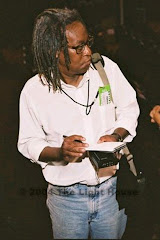
-jeffery mcnary
NEWCITY
Staying true to its charge of working primarily with emerging artists, Around the Coyote’s 1st Annual Painting Competition and Exhibition convincingly expands those efforts for painters. In the past, the gallery played host to open-call shows for works on paper and photography. In lending its resources to those striving for footholds in the paint medium, Matthew Hallinan’s “Energumeno,” a large, vibrant oil on canvas with surrealist leanings emerged as the premier piece of this exhibition. There are figures partying and one waving a Sandinista flag from the rooftop.
“The purpose of these types of shows are really to just give artists more exhibition opportunities, so they can show their work, meet other artists in the same discipline, meet art patrons, collectors, curators, etcetera,” says Anne Mills, Around the Coyote’s executive director.
This show’s curator, Sara Schnadt of the City’s Department of Cultural Affairs office, selected the ten finalists for the exhibition based upon images of their work, artist statements and biographical information relative to their work and personal styles. Artists paid an application fee of fifteen-dollars, and the financial award for the winner is yet to be determined. Schnadt selected Hallinan’s work based upon her perception of his “vision, technique and how that technique had been developed.”
Elizabeth Kauffman’s work, “Page 249.” a technically sophisticated watercolor and graphite on paper, noted that juried shows wrestle with “institutionalized” points of view and expectations. Nonetheless, she, as does John Mosher, whose open-ended pieces of loose color and hard black lines resemble those of illustrator Ralph Steadman, concur that showing in this forum is exciting, a “breakout thing.”
Hearing his work held the “strongest images,” Hallinan explains his process: “I have in my mind a mental sketch. I manipulate pieces which otherwise wouldn’t exist. I use poetic devices. There are only a few tubes of color put into this,” he says, “I’m thrilled.” (Jeffery McNary)
“The purpose of these types of shows are really to just give artists more exhibition opportunities, so they can show their work, meet other artists in the same discipline, meet art patrons, collectors, curators, etcetera,” says Anne Mills, Around the Coyote’s executive director.
This show’s curator, Sara Schnadt of the City’s Department of Cultural Affairs office, selected the ten finalists for the exhibition based upon images of their work, artist statements and biographical information relative to their work and personal styles. Artists paid an application fee of fifteen-dollars, and the financial award for the winner is yet to be determined. Schnadt selected Hallinan’s work based upon her perception of his “vision, technique and how that technique had been developed.”
Elizabeth Kauffman’s work, “Page 249.” a technically sophisticated watercolor and graphite on paper, noted that juried shows wrestle with “institutionalized” points of view and expectations. Nonetheless, she, as does John Mosher, whose open-ended pieces of loose color and hard black lines resemble those of illustrator Ralph Steadman, concur that showing in this forum is exciting, a “breakout thing.”
Hearing his work held the “strongest images,” Hallinan explains his process: “I have in my mind a mental sketch. I manipulate pieces which otherwise wouldn’t exist. I use poetic devices. There are only a few tubes of color put into this,” he says, “I’m thrilled.” (Jeffery McNary)





